
Commentary
May 18, 2003
Updated January 21, 2008
Murray Hill
.....
¶ Academics and researchers associate Murray Hill with the famous New Jersey-based Bell Labs (now ATT), home of many great inventions and interesting projects. But for typographers, Murray Hill is Emil J. Klumpp's script font developed in 1956 at Kingsley/ATF. New York-based Emil Klumpp (b. 1912) became type director at American Type Founders in 1964. It is hilarious that Linotype calls Emil Erich and that MyFonts filed his work under Emil Klump (one "p"). Anyway, the status of the Murray Hill typeface is unclear as the entire ATF collection has been donated to the Smithsonian in the early nineties. Many versions of Murray Hill have been published since then. What prompted me to write this page was a biting comment on a type forum regarding a small foundry's adaptation of Murray Hill. My question to that poster is: which of the versions below are legally or morally acceptable, in your eyes? And what is the error then, in the small foundry's attempt to make its own version? Is it not more outrageous that almost all major foundries have their own "versions" of Murray Hill, without ever sending a dime to Emil Klumpp, who died a poor man [more about that below].
Emil Klumpp
¶ Let us begin with Klumpp's life as communicated to me by one of his ex-colleagues and associates.
¶ He starts: I first met Emil Klumpp in 1955 at a meeting of ATF Dealers in Chicago. He was a featured speaker and presented Murray Hill as a new type face he had been commissioned to be drawn based on the need for a modern non-connecting script by Type Division Manager Jan Vander Ploeg. Murray Hill, the original face, was deemed to weak and did not sell well as did heavier faces like Brush. So he drew Murray Hill Bold, completed in 1956. I have two panels on my wall signed and dated April 7. The art for Murray Hill was destroyed in a fire in his studio.
¶ Emil was paid $1,500 for each face plus a commission of five cents a pound for every pound sold. This was, of course, metal type and he made good money as the Bold version sold well for a number of years.
¶ I am certain that ATF was owned by American Bank Note in those days. I know they owned ATF when I joined the company in 1963. I still have engraving from their spectacular calendars on my walls. Kingsley bought them as the company came to the end of it's life to keep the foundry running and producing hard metal zinc type used in their marking machines. I would guess this was in the 80's.
¶ Emil was hired a General Manager of the Type Division in the late fall of 1962 or it could have been January 2, 1963 after spending a year as an ATF Regional Manager. He hired me as his replacement from an ATF Dealer in Grand Rapids Michigan with the blessings of that company. Guess they were glad to get rid of me. The position required full time travel and I was sent home to talk to my wife before I could accept the job. Emil had replaced Jan who moved back to The Netherlands to manage the web press division.
¶ Emil told me the face was named after the Murray Hill telephone exchange which happened to be that of a girl friend in NYC.
¶ We both left the company in 1966, He became President of Bauer Alphabets US in NYC and I hired on as Executive Director of the International Typographic Composition Association in Washington DC.
¶ There were other more personal anecdotes that Klumpp's friend told me, but they are not important. What matters was that Klumpp somehow managed to spend all his money and that he died as a poor man at age eighty.
¶ Klumpp's friend is very passionate about it. Quite upset by the situation, he went on to say: I wonder how many firms lay claim Ad Lib, designed by Freeman Craw, or Craw Clarendon for that matter. [...] I still think you should see who usurped Ad Lib. I see it all the time on TV and in print, almost as much as Murray Hill Bold on Florists Trucks.
¶ I will deal with the rape of Ad lib elsewhere, promised. The remainder of this page is dedicated to Klumpp.
The versions
¶
The (digital) versions of Murray Hill include:
The alphabet
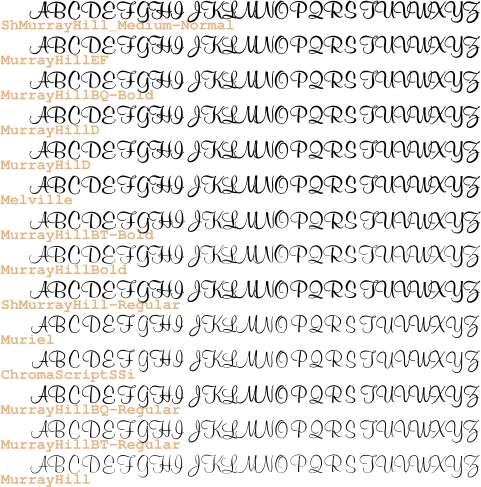
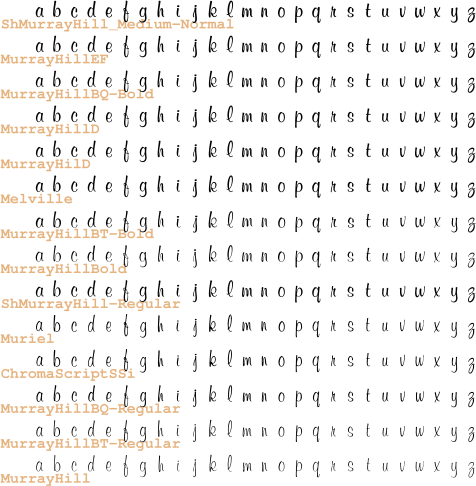
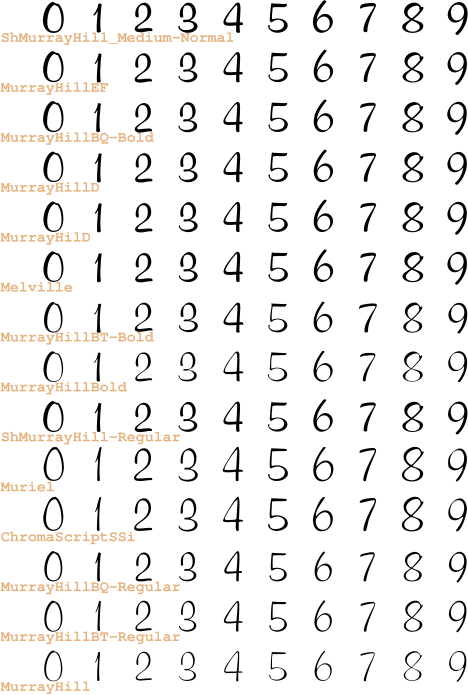
¶ Hard to make out which version to prefer in this list. I find the Image Club Graphics "Murray Hill" a bit thin (and on closer inspection, some outlines are imperfectly aligned). Its "Murray Hill Bold" has the greatest contrast, and that too causes some problems in execution.
¶ The lower case "o" splits the typefaces into ChromaScriptSSi and Muriel on the one hand, and everyone else. Upon closer scrutiny, ChromaScriptSSi and Muriel are fundamentally identical, with only cosmetic Bezier control point changes. ChromaScriptSSi is in fact grotesquely scarred (see "6") by incompetent control point manipulation.
¶ MurrayHillBQ-Regular suffers from a skin disease (check the lower case "a" or the top part of the "d"). This leaves SoftMaker, Bitstream, Elsner&Flake, URW and Mannesmann-Scangraphic in the competition. Now ask the question: what business did these companies have making and selling Murray Hill imitations? How many of them are supporting the heirs of Emil Klumpp?
Bezier outlines
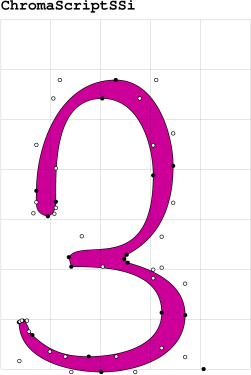
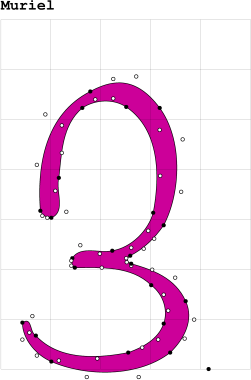
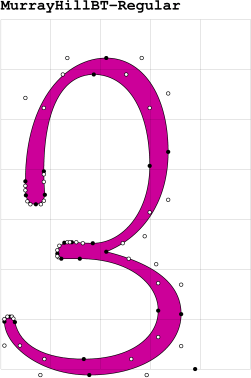
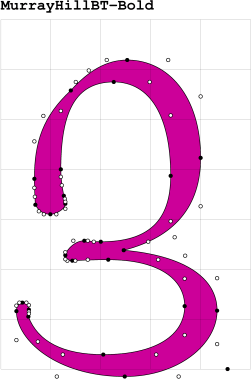
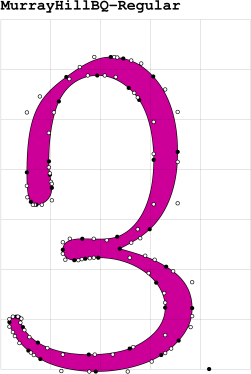
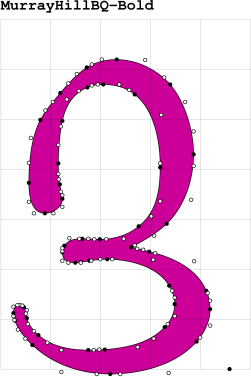
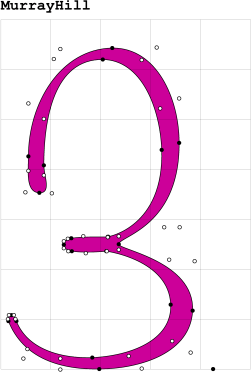
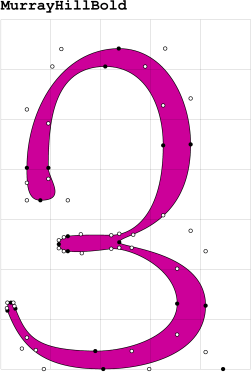
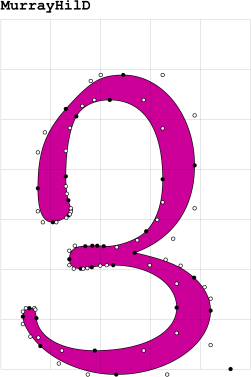
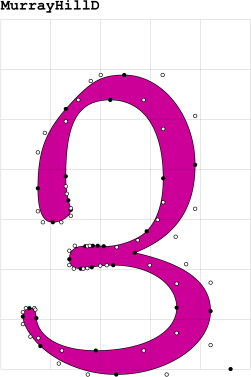
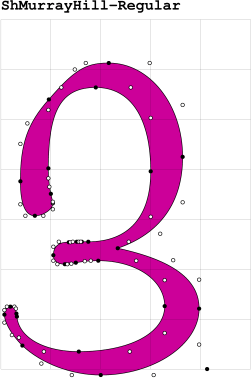
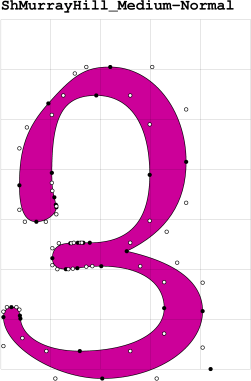
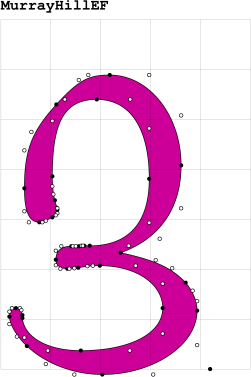
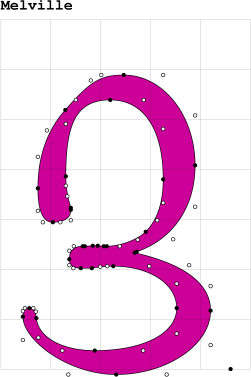
Copyright © 2003
Luc Devroye
School of Computer Science
McGill University
Montreal, Canada H3A 2K6
lucdevroye@gmail.com
http://cg.scs.carleton.ca/~luc